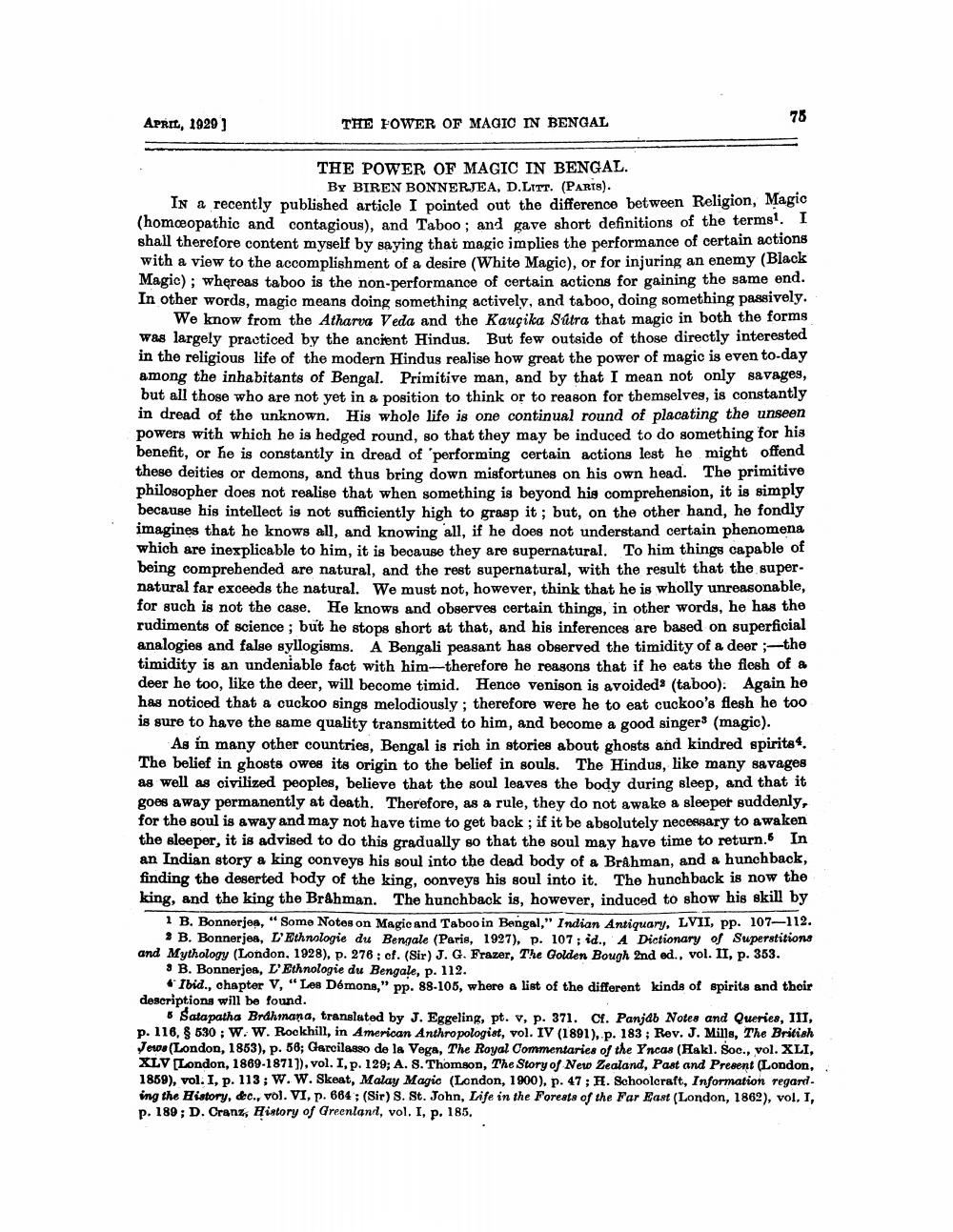________________
APRIL, 1929)
THE POWER OF MAGIC IN BENGAL
THE POWER OF MAGIC IN BENGAL.
BY BIREN BONNERJEA, D.LITT. (PARIS). IN a recently published article I pointed out the difference between Religion, Magic (homoeopathic and contagious), and Taboo ; and gave short definitions of the termst. 1 shall therefore content myself by saying that magic implies the performance of certain actions with a view to the accomplishment of a desire (White Magic), or for injuring an enemy (Black Magic); whereas taboo is the non-performance of certain actions for gaining the game end. In other words, magic means doing something actively, and taboo, doing something passively.
We know from the Atharva Veda and the Kauçika Satra that magic in both the forms was largely practiced by the ancient Hindus. But few outside of those directly interested in the religious life of the modern Hindus realise how great the power of magic is even to-day among the inhabitants of Bengal. Primitive man, and by that I mean not only savages, but all those who are not yet in a position to think or to reason for themselves, is constantly in dread of the unknown. His whole life is one continual round of placating the unseen powers with which he is hedged round, so that they may be induced to do something for his benefit, or he is constantly in dread of performing certain actions lest he might offend these deities or demons, and thus bring down misfortunes on his own head. The primitive philosopher does not realise that when something is beyond his comprehension, it is simply because his intellect is not sufficiently high to grasp it ; but, on the other hand, he fondly imagines that he knows all, and knowing all, if he does not understand certain phenomena which are inexplicable to him, it is because they are supernatural. To him things capable of being comprehended are natural, and the rest supernatural, with the result that the supernatural far exceeds the natural. We must not, however, think that he is wholly unreasonable, for such is not the case. He knows and observes certain things, in other words, he has the rudiments of science; but he stops short at that, and his inferences are based on superficial analogies and falge syllogisms. A Bengali peasant has observed the timidity of a deer ;-the timidity is an undeniable fact with him—therefore he reasons that if he eats the flesh of & deer he too, like the deer, will become timid. Hence venison is avoided (taboo). Again ho has noticed that a cuckoo sings melodiously; therefore were he to eat cuckoo's flesh he too is sure to have the same quality transmitted to him, and become a good singer (magic).
As in many other countries, Bengal is rich in stories about ghosts and kindred spirits 4. The belief in ghosts owes its origin to the belief in souls. The Hindus, like many savages as well as civilized peoples, believe that the soul leaves the body during sleep, and that it goes away permanently at death. Therefore, as a rule, they do not awake a sleepet suddenly, for the soul is away and may not have time to get back; if it be absolutely necessary to awaken the sleeper, it is advised to do this gradually go that the soul may have time to return. In an Indian story a king conveys his soul into the dead body of a Brahman, and a hunchback, finding the deserted hody of the king, conveys his soul into it. The hunchback is now the king, and the king the Brahman. The hunchback is, however, induced to show his skill by
1 B. Bonnerjea, "Some Notes on Magic and Taboo in Bengal," Indian Antiquary, LVII, pp. 107-112.
B. Bonnerjea, L'Ethnologie du Bengale (Paris, 1927), p. 107; id., A Dictionary of Superstitions and Mythology (London, 1928), p. 276: cf. (Sir) J. G. Frazer, The Golden Bough 2nd ed., vol. II, p. 353.
I B. Bonnerjea, L'Ethnologie du Bengale, p. 112.
Ibid., chapter V, "Les Démona," pp. 88-105, where a list of the different kinds of spirits and their descriptions will be found.
6 Sata patha Brahmana, translated by J. Eggeling, pt. v, p. 371. Cf. Panjab Notes and Queries, 111, p. 116, § 530 ; W. W. Rockhill, in American Anthropologist, vol. IV (1891), p. 183; Rev. J. Mills, The British Jews (London, 1853), p. 58; Garcilaso de la Vega, The Royal Commentaries of the Yncas (Hakl. Soc., vol. XLI, XLV (London, 1869-1871]), vol. I, p. 129; A. S. Thomson, The Story of New Zealand, Past and Present (London,. 1869), vol. I, p. 113; W. W. Skeat, Malay Magic (London, 1900), p. 47: H. Schooleraft, Information regard. ing the History, doc., vol. VI, p. 684; (Sir) S. St. John, Life in the Forests of the Far East (London, 1862), vol. I, p. 189; D. Cranz, History of Greenland, vol. I, p. 185.




